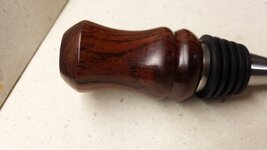This was my first bottle stopper and I had so much fun working it out. It was made from Cocobolo.
2 things:
First is, after I parted off the top and went through my abranet grit progression (wet sanding with walnut oil) I could not get rid of the circles seen in the pic. What is the best way to finish the area that gets parted off?
Second thing, the pic shows a crack along one of the grain lines. I found this as I was finishing up the turning. I filled it with CA and sanded it down but was still visible. What if anything should I have done to improve the appearance and strength?
Cheers.
2 things:
First is, after I parted off the top and went through my abranet grit progression (wet sanding with walnut oil) I could not get rid of the circles seen in the pic. What is the best way to finish the area that gets parted off?
Second thing, the pic shows a crack along one of the grain lines. I found this as I was finishing up the turning. I filled it with CA and sanded it down but was still visible. What if anything should I have done to improve the appearance and strength?
Cheers.


